كنيسة مار ميخائيل للموارنة (الزاهرية) St. Michael Maronite Church (Zahriyeh)

هذه الكنيسة قديمة العهد. فعندما أتى المطران بولس موسى إلى الأبرشية سنة هذه الكنيسة قديمة العهد. فعندما أتى المطران بولس موسى إلى الأبرشية سنة ١٨٢٦، كانت موجودة على شكل قبو عقد من حجر رملي، ولا يوجد تاريخ لتأسيسها. كان بجوارها حديقة صغيرة كان يسكنها نواب الأساقفة العامون في طرابلس لأن سكن الأسقف كان في دير مار يعقوب كرم سده. ولم ينتقل النائب العام منها إلا بعد بناء قلعة الطيب الحالية في ١٩٢٧.
هذه الكنيسة هدمت في سنة ١٨٥٨ لبناء الكنيسة الجديدة ببنيتها الحالية التي انتهت في سنة ١٨٨٩. بين سنة ١٩٠٨، عند مجيء المطران عويضة، وسنة ١٩١٢ تم استحصال إذن من الباب العالي لترميمها. في سنة ١٩٢٣ تم ترميمها مع ترميم وإضافة غرف قربها معدة لسكن الكهنة خدامها والأسقف عند نزوله إلى طرابلس.
فقد جرى هذا الترميم بهمة وسعي وإشراف يوسف أفندي الفاخوري، شقيق المونسنيور إرسلان يوسف الفاخوري الذي كان نائبًا عامًا على الأبرشية. ثم تجددت بعهد المطران عبد علي ما هي عليه الآن. كذلك تم حينها هدم الغرف القديمة وبناء بناية اقتطعت قسمًا من مساحتها وهي مؤلفة من عدة طوابق.
كما تم بعد ذلك بناء قبة عالية هدفها إيصال صوت الجرس للمؤمنين. لا يمكننا الوصول إلى كاتدرائية الملاك ميخائيل في منطقة الزاهرية في مدينة طرابلس من دون الغوض في الذاكرة الجماعية التاريخية للمدينة القديمة فيها.
ان هذه الكاتدرائية بنيت على أنقاض كنيسة صليبية ولديها بعدا تاريخيا عميقا. وهي مخفية بين الازقة داخل المدينة القديمة كما كانت الابنية القديمة مخفية في القرون الوسطى ولا يستطيع المرء رؤيتها عن بعد ما يعطيها أهمية أكثر بكثير ما تسمعه عنها لأننا لا نشاهدها إلا بشكل مفاجئ.
ان سور الكاتدرائية وبرجها الضخم يحولانها إلى قلعة مقفلة على نفسها الا أننا ومع دخولنا إليها يتغير المشهد فيبرز العقد مشغولا بدقة مستندا إلى ركائز ضخمة ومنقوشة. أما المذبح فهو مصنوع من الرخام الثقيل الملون بلونين محاطا بملاكين اثنين من حجر الرخام الأبيض الناصع والمشغول بدقة وعناية. أما البرج المضاء فإنه يعبر عن الحدث الذي نحتفل به إضافة إلى كونه يشكل حدثا بحد ذاته وتركيبة فنية.
وأكثر من الحجارة القديمة هو التحدث عن شبيبة الكشافة في الرعية بابتساماتهم الجميلة النضرة وبأعينهم التي تشع ايمانا وقوة.
This church is very old. When Bishop Paul Moussa came to the diocese in 1826, it existed in the form of a sandstone vault, and there is no date for its founding. Next to it was a small garden where the vicars general of Tripoli used to live because the bishop’s residence was in the monastery of St. Yacoub Karam Sadeh. The vicar general did not move out until after the construction of the current Tayeb Castle in 1927.
This church was demolished in 1858 to build the new church with its current structure, which was completed in 1889. Between 1908, when Bishop Oweida arrived, and 1912, permission was obtained from the High Council to restore it. In 1923, it was restored and rooms were added near the church to house the priests, ministers, and the bishop when he traveled to Tripoli.
This renovation was carried out by Youssef Effendi al-Fakhoury, brother of Monsignor Erslan Youssef al-Fakhoury, who was vicar general of the diocese. Then it was renovated during the reign of Bishop Abd Ali to what it is now. The old rooms were demolished and a multi-story building was built on top of them. A high dome was then built to bring the sound of the bell to the faithful.
We cannot arrive at the Angel Michael Cathedral in Tripoli’s Zahiriya district without delving into the historical collective memory of the old city. This cathedral was built on the ruins of a Crusader church and has a deep historical dimension. It is hidden between the alleys inside the old city, just as old buildings were hidden in the Middle Ages, and one cannot see it from a distance, which gives it much more importance than what you hear about it because we only see it unexpectedly.
The cathedral’s wall and huge tower turn it into a locked castle, but as we enter the cathedral, the scene changes and the intricately crafted arches resting on huge, carved pillars emerge. As for the altar, it is made of heavy marble colored in two colors, surrounded by two angels made of pure white marble stone.
As for the lighted tower, it expresses the event we are celebrating, in addition to being an event in itself and an artistic composition. More than the ancient stones is to talk about the young scouts in the parish with their beautiful, fresh smiles and eyes that radiate faith and strength.
